Oklahoma tornado: Resilience amid the ruins
- Published
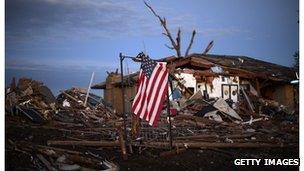
The tornado in Moore levelled almost everything in its path.
"Like a war zone" is a horribly overused simile. Teenage bedrooms. Bad traffic jams. Rubbish on the streets hours after a demonstration.
So forgive me, but here goes - the city of Moore, a southern suburb of Oklahoma City, really is the closest thing to looking like a war zone without, well, being one.
There are the big things that hit you first: the medical centre, a rambling, squat, three-storey yellow-brown structure that looks as if a car bomb, a big one, has gone off outside it, ripping out a great chunk of roof and exposing along one long facade its shiny steel skeleton.
In the car park, twisted chunks of mud-covered metal lie at odd angles - what were once hard-saved-for cars, swept and up and smashed by the force of the blast that destroyed the building.
Debris everywhere
The telegraph poles, snapped at their bases like broken pencils; the small houses, pulverised as if a giant hand had come down from the sky and - bam, bam, bam - crushed them without a flicker of effort.
The offices and shops along a main street, ripped open, ripped apart, ripped in two.
And then, when your slack mouth has finally shut and you can shuffle around the area for a closer look, there are the smaller things.
The debris - most of it small pieces of wood - that has been spread across every square inch of ground; the bent bike sandwiched between bricks and broken wood; a chair with an embroidered cushion standing on a pile of bricks, what looks like a dress draped across its back.
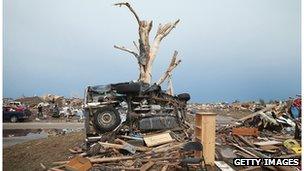
Families returned to an American suburb that looked more like a moonscape.
A book, its cover emblazoned with the title Family First, next to a couple of mud-covered saucepans, nestling in the wreckage of what was once a family home; a black SUV, mud-spattered, each of six windows blown in, the remains of a tree resting up against it, the indicator in its passenger wing-mirror winking on and off.
And at the medical centre, embedded in the skin of the building, spears and shards of wood carried god-knows-what distance and thrown with such force that they stick proudly into the ruined hospital's exterior.
A piece of twisted aluminium glints in the sunshine, similarly suspended.
Unbroken spirit
Of course, remind yourself, Moore is not a war zone. Militias have not rampaged up and down its streets. Car bombs have not been left outside hospitals. Rocket-propelled grenades have not ravaged its neat homes.
It was the wind that did this.
There is something else strange about Moore. Put simply, the houses are broken (and the cars, and the school, and the street signs), but the people are not.
You would have thought that, 15 or 20 hours after an event like this, the place would be flat on its back.
And when, around midday on Tuesday, the rain slashed down and a chill wind swept over the area, it was difficult to see where even to start the monumental task of clearing up, let alone of re-constructing.
A pick-up truck took a weary 10 minutes to clear a smashed and twisted car from the rain-slicked road, eventually abandoning efforts to drag it with chains, simply shunting it to one side.
But clearing up has started. By Tuesday afternoon - not even 24 hours after the tornado swept all before it - chain saws were buzzing in the streets around the medical centre.
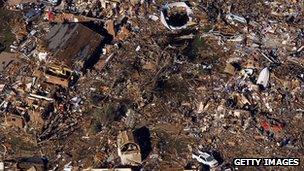
President Obama promised federal aid to supplement state and local recovery efforts.
A crew - in hard hats and work-shirts with first names stitched on to the breast pockets - were hard at work on the power lines, one up a cherry picker with a power drill stripping off the old broken metal brackets and broken woodwork.
Brandon, down by the truck and labouring over a stack of new telephone poles, said he had got the call just two and half hours after the tornado struck. He had got up at five on Tuesday morning, driven a hundred miles and set to work.
A pretty swift response, I asked?
"It's what we do every day," said Brandon, with a slight shrug and not a shred of false modesty.
And how long would the crew work today?
"Until they tell us to quit," he said and chuckled.
Up one of the devastated side streets it was the same story from Zack Woodchuck, who had gone back to his ruined house to see what was worth salvaging. The answer, he found, was very little.
So would he rebuild? "Of course," he says, "we'll rebuild it. We're starting right now".
"We're cleaning up. We've gotta start somewhere. We'll be fine. We've done it before."
Volunteers
By the end of most people's working day - just 25 hours after the tornado struck - the medical centre was fenced off, ruined cars fit only for the dump marked up and ready to go.
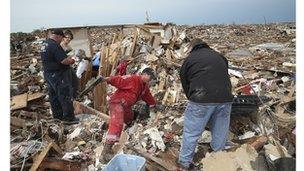
The clear-up began almost as soon as the storm was over
Volunteers strode the streets handing out water and sandwiches to those suddenly without kitchens or larders.
By the roadside, a long stretch of twisted metal and assorted detritus had been collected, ready to be carted away.
There will no doubt be recriminations in the coming days - over the lack of shelters, the lack of warning, the difficulties of reconstruction.
But the way Americans bounce back is a constant source of wonder. Maybe it takes the worst to bring out the best.
- Published22 May 2013
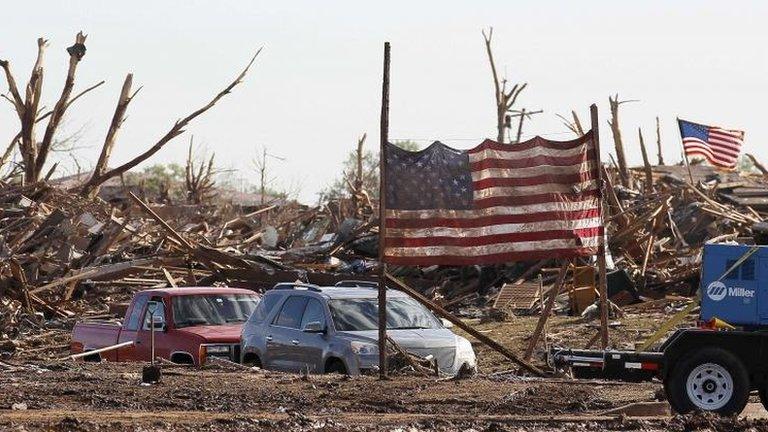
- Published22 May 2013
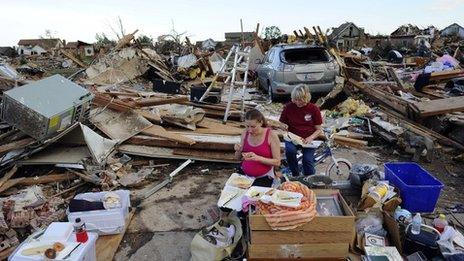
- Published22 May 2013
